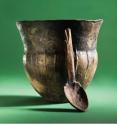Ancient cooking pots reveal gradual transition to agriculture
Humans may have undergone a gradual rather than an abrupt transition from fishing, hunting and gathering to farming, according to a new study of ancient pottery. Researchers at the University of York and the University of Bradford analysed cooking residues preserved in 133 ceramic vessels from the Western Baltic regions of Northern Europe to establish whether these residues were from terrestrial, marine or freshwater organisms.
The research led by Oliver Craig (York) and Carl Heron (Bradford) included an international team of archaeologists from The Heritage Agency of Denmark, The National Museum of Denmark, Moesgård Museum (Denmark), Christian-Albrechts-Universität, Kiel (Germany) and the Archäologisches Landesmuseum, Schleswig (Germany).
The project team studied ceramic pots from 15 sites dating to around 4,000 BC- the time when the first evidence of domesticated animals and plants was found in the region. The research, which was funded by the Arts and Humanities Research Council, is published online in the latest edition of the Proceedings of the National Academy of Sciences (PNAS).
The research team found that fish and other aquatic resources continued to be exploited after the advent of farming and domestication, with pots from coastal locations containing residues enriched in a form of carbon found in marine organisms.
Around one-fifth of coastal pots contained other biochemical traces of aquatic organisms, including fats and oils absent in terrestrial animals and plants. At inland sites, 28 percent of pots contained residues from aquatic organisms, which appeared to be from freshwater fish.
Lead author Dr Oliver Craig, of the Department of Archaeology at York, said: "This research provides clear evidence people across the Western Baltic continued to exploit marine and freshwater resources despite the arrival of domesticated animals and plants. Although farming was introduced rapidly across this region, it may not have caused such a dramatic shift from hunter-gatherer life as we previously thought."
Carl Heron, Professor of Archaeological Sciences at the University of Bradford, said: "Our data set represents the first large scale study combining a wide range of molecular evidence and single-compound isotope data to discriminate terrestrial, marine and freshwater resources processed in archaeological ceramics and it provides a template for future investigations into how people used pots in the past."
Source: University of York
Other sources
- Pots are evidence of slow change to farmsfrom UPIMon, 24 Oct 2011, 22:50:14 UTC
- Pots are evidence of slow change to farmsfrom UPIMon, 24 Oct 2011, 21:50:20 UTC
- Ancient cooking pots reveal gradual transition to agriculturefrom Science DailyMon, 24 Oct 2011, 21:30:29 UTC
- Food remains in ancient cooking pots suggest farming caught on slowlyfrom The Guardian - ScienceMon, 24 Oct 2011, 19:30:52 UTC
- Ancient cooking pots reveal gradual transition to agriculturefrom PhysorgMon, 24 Oct 2011, 19:30:46 UTC
- Dirty pots reveal ancient fish suppersfrom Chemistry WorldMon, 24 Oct 2011, 19:10:20 UTC
